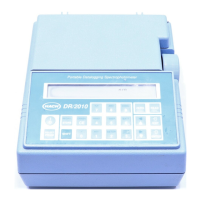71
• Piecewise Linear: C = Piecewise
• Linear: C = a + bA (requires ≥ 2 data points)
• Quadratic: C = a + bA + cA
2
(requires ≥ 3 data points)
• Cubic: C = a + bA + cA
2
+dA
3
(requires ≥ 4 data points)
Where: a, b, c, and d are coefficients,
A = Absorbance and C = Concentration.
Three types of equations (linear, quadratic, or cubic) can be used
by entering values for the coefficients into the formulas that
describe these curves. To enter a calibration curve using the cubic
equation option, press the
DOWN ARROW key twice at the
Calib Table: 0 display. Press ENTER at the Calib Formula: F3
display. Proceed with Step 36. The instrument will prompt for
the coefficients.
24. Press
ENTER. The display will show:
The appropriate timing intervals in the procedure must be used when
preparing the zero concentration and calibration standards.
Note: Follow the
procedure steps
for reagent
addition and color
development to
make the
standards and
blank before
using them for
calibration.
25. Place a sample cell containing the blank or zeroing solution in the cell
holder, close the cover and press
ZERO. If the wavelength is not
correct, the display will prompt you to dial in the correct wavelength.
Adjust the wavelength and press
ZERO again.
26. The instrument displays:
then:
The actual units and decimal place displayed depend on the selections
made earlier.
nm
+8.8.:8.8.
ÿÿÿÿÿÿÿÿÿÿÿÿÿÿÿÿ
888500
*
Zero Samðle
nm
+8.8.:8.8.
ÿÿÿÿÿÿÿÿÿÿÿÿÿÿÿÿ
888590
*
Zeroinç...
nm
+8.8.:8.8.
ÿÿÿÿÿÿÿÿÿÿÿÿÿÿÿÿ
888500
*
#1 0.000

